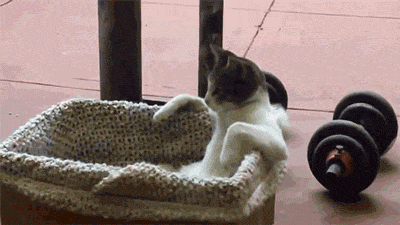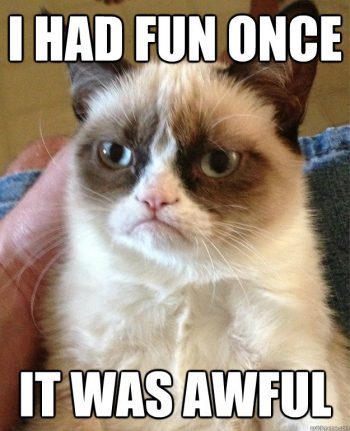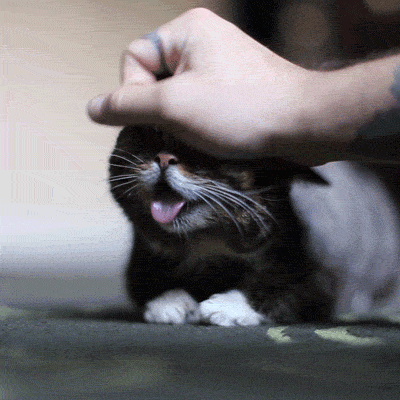from a cat to 'the cat' -
why some cats are famous.
Ever notice how you see the same cat images over and over... and over? We dared to ask why. In a digital world ruled by cats, some stand head and paws above the rest.
by Taryn S.
27. Nov. 2018.
Last update:
April 7, 2019
Cat celebrities...huh?
As we watched our cat videos and browsed through cat memes on Imgur, we were struck by a thought. Why is it that we’re seeing the same set of cat memes over and over? Why are some cats more famous than others?
A quick Google would answer that question for us…Or so we thought. Apparently, the question hadn’t been asked often enough. So, we figured we should answer it ourselves and tell the world what we found.
To really understand why cats become celebrities or otherwise become famous, we took a step back and explored why it is that we enjoy watching cats in the first place. From there, we could work out why we enjoy watching specific cats over others.
To walk you through our somewhat disturbed and conveniently biased explorations, we’ve split this article into two parts. Firstly, we explain why cats go viral. Then we extend this understanding of ‘cat virality’ to unravel the true reason for cat fame.

Why do cats go viral?
It could be because they’re cute. We love cute things. In fact, there’s science behind it. When we encounter something cute, the parts of our brain relating to pleasure, empathy and compassion are stimulated – resulting in an overwhelming desire to protect [1] or squish, squeeze, smother, and love to death.
This instinct is designed for human infants, but it also extends to animals- especially those with juvenile features such as big eyes, oversized heads and recessed chins [1]. Does this sound like any famous cats that you know?
Kitty, Y U no love me?
Do you ever feel like you want what you can’t have? Maybe all that you want in life is your cat’s unwavering love and affection (or any cat’s for that matter). Unfortunately, unless it is dinner time, it’s unlikely that you will get the attention that you so desperately want from your little ball of fur. He or she is entirely dis-interested in you – or at least that’s how we perceive it. Despite the stereotypes that cats don’t care much for their humans, they do occasionally surprise us with a cuddle. This leads to a “partial reinforcement” for our behaviours, and to a greater longing for the cats attention [2]. We throw ourselves into an internal struggle to regain or re-affirm the cats love when is perceived to be taken away from us [3].
When it comes to observing cats through media, you also lack the ability to interact with the super cute thing that you need to smother with love. Once again you have been denied something, and this time it’s an almost primal desire – so it’s probably driving you nuts.
If you think that being needy and selfish is the darkest side of your love for cat content – think again. It’s time to talk videos.
A more sinister reason at play.
Voyeurism – The act of taking guilty pleasure in watching someone/thing anonymously.
This term is usually associated with taking sexual pleasure in watching a nude person without their knowledge, or generally describing the behaviours of a ‘peeping tom’. It seems fitting that we can broaden the definition of voyeurism to include varying types of media – and as the only possible explanation for the success of the TV show ‘Big Brother’. It also influences the way that we look at cat videos.

Whilst there is no sexual arousal, we still experience that feeling of ultimate power arising from anonymity and cat’s inability to do anything about our prying eyes. It’s the same feeling we experience while watching reality TV programs, or even movies like ‘The Truman Show’ [4][5]. What is a cat video if not its own form of reality entertainment? Combine this with our desire to gain cats attention (as described earlier), and their distinct lack of interest in the camera – you are presented with an opportunity that is too good to pass up. Our innate voyeuristic tendencies thrive on the ability to watch (in this case a cat) that we want to impress, with complete anonymity and without being observed in return.
There are other factors that lead to entertaining cat videos such as; ‘epic fails’ and animals doing things that they shouldn’t – like using a human toilet or a cat ‘barking’ like a dog. While these factors do contribute to the popularity of cat videos, they are not unique to cats.
What have we learnt so far?
Cats are cute. They neither know nor care that they are being watched. Finally, they don’t seek our approval. That’s the perfect formula for streaming hours of cat videos.
But if it was that simple, why aren’t all the other cats famous?
The secret behind the famous cats.
Two of the world’s most famous cats are Grumpy Cat and Lil Bub – if you don’t know who they are, you probably should have stopped reading at “cats”.

With a combined total of almost 80 million views on their official Youtube channels (as of writing) [10][11], 11.5 million likes on their Facebook pages [12][13], these two are clearly celebrities among the world of cats online. This begs the question; what makes us watch more of some cats than others? Why are only some cats celebrities?
What magical button was pressed to propel them into fame?
Let’s look at Lil Bub and Grumpy Cat in a bit more detail. The first thing that we notice when we look at these two is that they were both born with physical abnormalities that render them cuter than the average cat. How could you possibly resist the urge to tug on Grumpy Cat’s frown, boop their noses, or poke your tongue back at Lil Bub? In both cases, they suffer from feline dwarfism, a condition that makes them, well…different, and perhaps more interesting.
It could be argued that their appearance gives them the edge over all other ‘normal’ cats. Perhaps it makes them more easily loved or more easily remembered. But why aren’t all cats with physical deformities or otherwise unique appearances famous? Evidently, there’s more to a cat’s fame than meets the eye. This isn’t just voyeurism, nor is it just wanting Grumpy’s or Lil Bub’s attention; heck, it’s not even partial reinforcement. Our explanation for why we like to watch cats simply cannot explain why we like to watch these specific cats.
What is it that these cats do differently to the rest?
They have a brand.
Let’s look at the definition of what a brand is. In the marketing literature, a brand is defined as [6]:
“A perceptual entity rooted in reality but reflecting the perceptions and idiosyncracies of consumers.”
A bit of a mouthful? Yeah, we thought so too. In the most simple and direct terms – a brand is a reputation. In most cases it is a perfectly sculpted reputation designed to appeal to a specific audience and maintain their loyalty.
With that in mind, what is the reputation of Grumpy Cat? Of Lil Bub? In the case of Grumpy at least, the answer is clear cut. She’s…grumpy. That’s her reputation. In reality, this kitty is as happy as any other – but if that’s what we saw her as, she wouldn’t be the Grumpy Cat that we adore. In other words, she simply wouldn’t be as famous as she is without the reputation of being grumpy. This then begs the question; how exactly did she get that reputation?
We could argue that her appearance would make ‘grumpy’ the natural conclusion from just, well, looking at her, however we think that’s a bit of a stretch. As brand developers, we know that brands – reputations – are built over time. They are built through consistent messaging amongst other things. What did Grumpy have that was consistent enough to give her the reputation of being grumpy? How does a cat called ‘Tardar Sauce’ go from such innocent beginnings to become a symbol of disapproval and contempt?

The simple answer is that memes did it, at least for Grumpy Cat. Going back over her internet history, she rose to fame in mid-2012 after the owners had uploaded her pictures to Reddit, with the aptly-named title ‘Meet grumpy cat’. The Reddit community responded with parodies of Grumpy, initially simply ‘turning her frown upside-down’ with questionable Photoshop skills. It wasn’t until somebody replied with a captioned image with statements of discontent from Grumpy’s perspective that the fire was truly lit [7]. As people began to adopt this new style of stating Grumpy’s discontentment, her online personality was slowly sculpted, setting in place a unique message of discontent for an otherwise happy cat.
As with any brand, the Grumpy Cat brand could never have been as popular as she was (and is, to this day) without active marketing efforts on the part of her owners. By keeping up the online presence of the cat and fuelling her fame through consistent uploads of images to Reddit and videos to YouTube, the owners made sure Grumpy did not escape the attention of her followers. Within 4 days of her initial images being uploaded to Reddit, a website was created to showcase her grumpiness. An official Twitter account was created within 10 days. To top it off, merchandise featuring Grumpy Cat were created within 7 days of the original Reddit post. Combined with the intensive marketing campaign and consistency of the ‘grumpy‘ message, Grumpy Cat shot into fame.
what about Lil Bub?
Lil Bub initially went viral for the same reason as Grumpy Cat – her appearance. But in this case, she is the most gosh-darn-adorable, derp-faced, little munchkin. Photos of her were initially uploaded to Tumblr and Instagram, however she did not make it to the public eye until months later when her Instagram photos rose to popularity. Then she, like Grumpy, made her way onto the front page of Reddit and her photos were picked up by Buzzfeed. After this, her popularity began to snowball [8]. This gave her the initial mass exposure and her cuteness naturally gave her the initial virality that she needed to captivate the attention of the world. But this alone couldn’t propel her into a celebrity status. No, she needed more than that. What she needed was, like Grumpy, a consistent message that would be backed by a relentless and sustained marketing effort.

Her initial popularity was backed by her ‘human’, Mike Bridavsky, in a campaign to print T-shirts, calendars, mugs and other miscellaneous promotional items that featured her face [8]. This effort ensured that she never escaped attention from her fans.
But she couldn’t go very far without a brand for herself. Sure, she was unique, but unlike Grumpy, she offered no tangible message. That was, until her owner made a very important decision.
By choosing to donate the bulk of the proceeds from her fame and popularity to charities that support the welfare of animals, the ‘human’ turned Lil Bub into a symbol of hope for animals across the globe. He has also ensured that Lil Bub‘s actions lined up perfectly with her message, as she travelled across the USA visiting animal rescue groups and shelters [9]. Her social media presence remains consistent and relevant to her cause. Though she didn’t have memes to say so, Lil Bub‘s message is as strong as it is positive. It is of hope, inspiration, and acceptance. Though she does express her share of wit and charm to boot.
Lil Bub isn’t just a cute cat that wants to make everyone happy, she stands for the welfare of animals everywhere -especially those with special needs. That’s her reputation; her brand.
Over the last 6 years, this fearless, space adventurer has quickly turned into a celebrity on the internet, but she could not have done it without the devotion of her owner to build her a strong brand, and to market it relentlessly.
What have Grumpy Cat and Lil Bub taught us about famous cats?
There are two main reasons for why these two fluff balls have held their positions in within popular culture:
- They were naturally predisposed towards going viral;
- Their owners took advantage of the initial virality by building a brand for the cats and marketing it with consistency to their online audience.
It seems to be fairly easy for a cat video to go viral. All that the recipe calls for a little bit of cute, a little bit of funny and a lot of cat. But staying famous is where the trick comes in, and as Grumpy Cat and Lil Bub demonstrate – it’s all about brand and marketing.
What is the take-home message?
We love cats, so an image or video of your furry little friend can sometimes go viral unintentionally. But there is a huge difference between a viral cat video and a cat being famous.
The most famous cats have a tailored brand. They are unique, easily recognisable and have a strong personality. In addition, their personality is linked to a brands message which is conveyed through appropriate marketing. In order for the cat to remain famous over time, it is important that brand is always being built upon and that marketing efforts (especially in the form of social media) stay up to date and relevant to their audience. Even after the cats themselves “walk The Rainbow Bridge”.
We already like watching cat videos and cooing over adorable photos, but it takes a brand (or reputation) to make a cat truly memorable. It’s the formation and maintenance of this brand that is the true secret to why some cats are more famous than others.
Now that’s out of the way, let’s get back to watching our favourite cat videos.
The References.
[8] Camile Dogero “Corporate Cats Still Suck: The Improbable Tale of Indie Superkitty Lil Bub” [online] available: https://www.spin.com/featured/lil-bub-indie-cat-mike-bridavsky/ [accessed 25 Nov. 2018]
[9] Lil Bub Official Site “About BUB” [online] available: https://lilbub.com/about [accessed 25 Nov. 2018]
[10] Lil BUB Official Youtube Channel [online] available: https://www.youtube.com/user/LilBubBub/about [accessed 25. Nov 2018]
[11] Grumpy Cat Official Youtube Channel [online] available: https://www.youtube.com/user/SevereAvoidance/about [accessed 25. Nov 2018]
[12] Lil Bub Official Facebook Page [online] available: https://www.facebook.com/iamlilbub/ [accessed 25. Nov 2018]
[13] Grumpy Cat Official Facebook Page [online] available: https://www.facebook.com/TheOfficialGrumpyCat/ [accessed 25. Nov 2018]